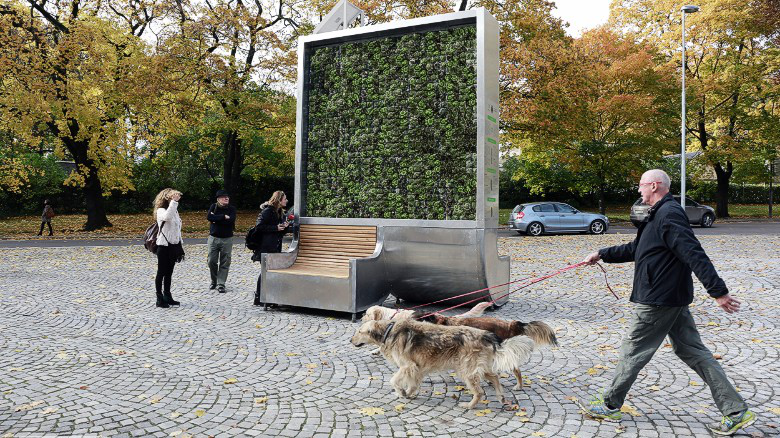
Air pollution is one of the world's invisible killers. It causes seven million deaths a year, making it the largest single environmental health risk. In urban areas, air pollution is particularly serious. More than 80% of people living in areas where pollution is monitored are exposed to air quality levels that exceed WHO limits. And given that by 2050 two thirds of the global population will be urban.
One well-established way to reduce air pollution is to plant trees, as their leaves catch and absorb harmful particulates. But planting new trees is not always a good choice for lack of enough space. That's why the "City Tree", a mobile installation which removes pollutants from the air, has been becoming popular in cities around the world, including Oslo, Paris, Brussels and Hong Kong.
Each City Tree is just under 4 meters tall, nearly 3 meters wide and 2.19 meters deep, available in two types: with a chair or a bench. A display is included for information or advertising. Berlin-based Green City Solutions claims its invention has the environmental benefit of up to 275 actual trees.
But the City Tree isn't, in fact, a tree at all— it's a moss culture. "Moss cultures have a much larger leaf surface area than any other plant. That means we can capture more pollutants," said Zhengliang Wu, co-founder of Green City Solutions.
The huge surfaces of moss in each tree can remove dust, nitrogen dioxide and ozone gases from the air. It requires very little maintenance: solar panels provide electricity, while rainwater is collected into a reservoir and then pumped into the soil.
To monitor the health of the moss, the City Tree has sensors which measure soil humidity, temperature and water quality. "We also have pollution sensors inside the installation, which help monitor the local air quality and tell us how efficient the tree is." Wu said. Its creators say that each City Tree is able to absorb around 250 grams of particulate matter a day and contributes to the capture of greenhouse gases by removing 240 metric tons of CO2 a year.
本时文内容由奇速英语国际教育研究院原创编写,未经书面授权,禁止复制和任何商业用途,版权所有,侵权必究!(投稿及合作联系:028-84400718 QQ:757722345)
1.The writer mentions the number of people living in urban areas to_______.
A stress that it is necessary to fight with the air pollution
B tell us the air quality levels exceed WHO limits
C say that the global population is increasing faster
D say that the air quality decides people’s health
解析:选A。推理判断题。根据文章第一段第二句It causes seven million deaths a year, making it the largest single environmental health risk. 和第三句的In urban areas, air pollution is particularly serious可知城市的空气污染是巨大的安全隐患,而作者又提到城市的人口多,据此可以推知作者是想告知控制城市的空气污染是必要的。故选A。
2.What made the City Tree popular in cities?
A It can be moved easily.
B It sends out harmful particulates.
C It saves much space.
D It can be stored only in big cities.
解析:选C。细节理解题。根据第二段第二、三句的But planting new trees is not always a good choice for lack of enough space. That's why the "CityTree", ...has been becoming popular in cities around the world可以得知植树不是一个很好的办法,the City Tree在城市里受欢迎是因为它节约空间。故选C。
3.What can people do beside the City Tree?
A They can count the number of the trees.
B They can give the useful information.
C They can have a good rest there.
D They can get close to some inventions.
解析:选C。细节理解题。根据第三段第一句的...available in two types: with a chair or a bench可以得知有两种类型:带椅子或者长凳,都可以供人休息。故选C。
4.What is the advantage of the City Tree?
A It can remove dust.
B It can collect rainwater.
C It is easy to manage.
D It helps produce water.
解析:选C。推理判断题。根据第五段第二句的It requires very little maintenance: solar panels provide electricity, while rainwater is collected into a reservoir and then pumped into the soil可以得知这种City Tree管理很简便。故选C。